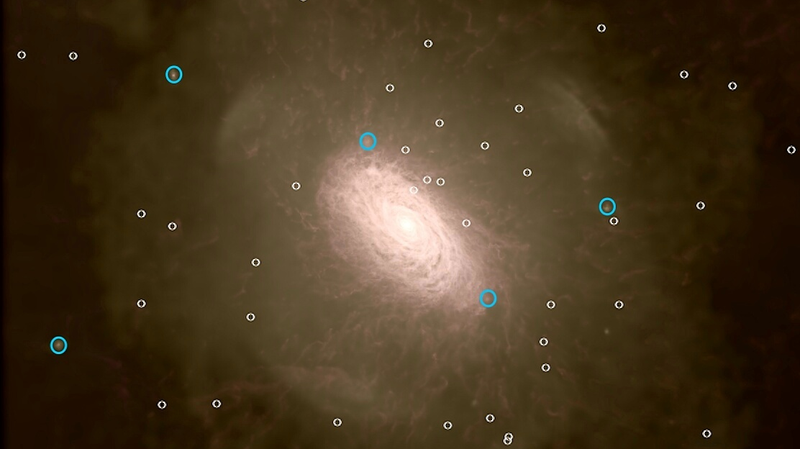
The Universe’s earliest epochs appear to be written into the small dwarf galaxies orbiting our own galactic home, the Milky Way.
A team of researchers studying dark matter noticed a strange trend in the brightness of the satellite galaxies around the Milky Way. There seem to be two classes of these orbiting dwarf galaxies—dim ones and bright ones—with few in the middle range. The researchers propose that this kink, when viewed on a graph, could be explained by a period early on in the Universe’s history called the re-ionization era.
“This kink feature that separates the old, faint population from the newer, brighter ones isn’t just what the theoretical model predicts,” study author Sownak Bose, from the Harvard-Smithsonian Center for Astrophysics, told Gizmodo. “It can be inferred from the data.”
Atoms started forming from protons and electrons a few hundred thousand years after the Big Bang. The resulting gas cooled, creating stars, but the stars didn’t last long. They exploded in huge supernovae, sending energy out into space. This split the atoms back up once again, “re-ionizing” them. It’s unclear when the first stars started to form or when re-ionization started, but they’re important periods in the Universe’s history, because they set the ball rolling to create the galaxies we see today.
The most widely accepted model says that galaxies are actually visible gas and dust coalescing inside larger haloes of a yet-to-be explained kind of mass called dark matter. Galaxies began forming with the first stars, but during the re-ionization period, astronomers think that temperatures rose too high, halting further galactic growth. Only at some later period, when large-enough dark matter halos coalesced, would the galaxy formation process pick up again.
Maybe, thought the researchers, the satellite galaxies surrounding the Milky Way could provide a signal of this reionization era. Small, dimmer satellites would have formed before the period, and brighter, larger galaxies would have formed afterward, with a gap in the middle representing re-ionization.
The researchers developed computer models and simulations to predict how many dwarf galaxies there should be for given brightnesses, according to the paper published today in The Astrophysical Journal. Data from the Milky Way and our neighboring Andromeda galaxy fit the model.
“We think that cosmic re-ionization is one of the main phenomenon that happened in the history of the Universe early on,” Azadeh Fattahi, researcher at Durham University in the UK who was not involved with this research (but who collaborates with the study’s authors), told Gizmodo. “Being able to see the footprints of that in the nearby Universe is quite exciting.”
Fattahi said that she was mostly convinced by the analysis, but had some reservations. “I’m not sure how the data will look in 10 years time. That’s my little worry, that maybe there are too few objects to come to a firm conclusion.”
Coral Wheeler, postdoctoral researcher at CalTech not involved with the study, told Gizmodo the result would be an extraordinary result if true. But she pointed out that the kind of “semi-analytic modeling” used has both strengths and weaknesses—they offer a simple way to model physical processes, but leave out some of the more complex processes and can be subjected to bias. “I would like to see the results of more than just the one type of statistical test used, and an analysis of how much the result relies on” one of the data points.
The study’s authors agreed that there’s more work to do. “One of the main caveats is that we can only identify these very faint dwarfs in our own galaxy. What if the Milky Way is weird? Or, what if the local sample of dwarfs is not representative of the whole population?” study author Alis Deason, also from Durham University, told Gizmodo. “Our models are far from complete—there are still many things we don’t understand about galaxy formation, particularly for these tiny dwarf galaxies. But that’s part of what makes them so interesting!”
You may have heard the phrase “absence of evidence isn’t evidence of absence.” That’s the main caveat here—but there are theoretical models and other lines of evidence to back up the paper’s conclusions, Bose said. That includes the ages of stars in these satellite galaxies, the way that interstellar dust changes the light from the most distant sources, and other data points. They seem to be in agreement with the presence of the gap.
But there are plenty of opportunities to take more observations and refine this result in the future.
Currently, it’s hard to spot the faintest dwarf galaxies on the Milky Way’s outskirts. “This should change very soon with missions such as LSST [the Large Synoptic Survey Telescope], which will probe to much greater depths than current facilities,” said Deason. After all, there’s a whole Universe of galaxies to observe. “Fortunately, with the advent of upcoming facilities like LSST, WFIRST, Euclid, and JWST, this will soon be achievable.”
[ApJ]
This post has been updated to include a comment from Coral Wheeler.
Bagikan Berita Ini














0 Response to "The Universe's Oldest Galaxies Could Be Right in the Milky Way's Backyard"
Post a Comment